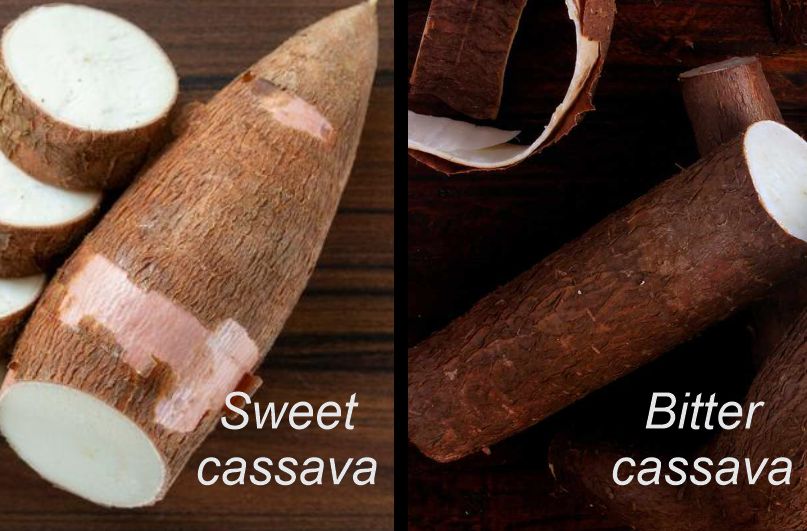Bitter vs sweet cassava differ in toxin levels, uses, and processing methods. Learn how to safely consume and utilize each variety for food and industrial purposes.
Cassava comes in two main types: bitter and sweet. While both provide essential nutrition and serve as a major food source, their differences go beyond taste.
Bitter cassava contains higher levels of cyanogenic compounds, requiring proper processing before consumption, whereas sweet cassava can be cooked and eaten directly.
The choice between the two depends on the intended use, fresh meals or processed products like flour and starch.
Understanding these differences is important for consumers and culinary enthusiasts alike, as they influence both cooking techniques and food safety considerations.
Recommended: Cassava in the United States: Everything to Know
Table of Contents
- Characteristics of Bitter Cassava and Uses
- Characteristics of Sweet Cassava and Uses
- Physical Characteristics of Sweet Cassava
- The Distinctive Traits of Bitter Cassava
- Nutritional Comparison and Health Implications
- Bitter vs Sweet Cassava – a Tabulated Comparison
- Conclusion
Characteristics of Bitter Cassava and Uses
Bitter cassava is distinctively recognized for its strong, pungent flavor profile, which gives it its name.
This variety of cassava contains high levels of cyanogenic glycosides, natural compounds that can release cyanide to cause cyanide poisoning when the cassava is improperly prepared or consumed raw.
This toxic characteristic underscores the importance of thorough processing to make it safe for consumption.
Traditional methods include soaking, fermenting, or cooking the cassava, effectively reducing harmful compounds without compromising the versatility and nutritional benefits of this root vegetable.
The taste of bitter cassava contrasts sharply with its sweet counterpart.
While sweet cassava is often characterized by a mild, nutty flavor suitable for various dishes, bitter cassava is used primarily in specific culinary applications that can tolerate or complement its intense taste.
Related: Signs Cassava is Ready for Harvest
A prevalent use is in the preparation of fufu, a staple food in West African cuisine, where cassava is pounded, often in combination with other ingredients, to create a textured dish that accompanies soups and stews.
Additionally, bitter cassava is utilized in the making of gari, a fermented product that serves as a common food in Nigeria and nearby countries.
Bitter cassava holds significant cultural importance among various communities.
In some regions, it has become a fundamental part of local heritage and is featured in traditional festivals and rituals.
The plant’s resilience and ability to thrive in diverse environments also contribute to its cultivation, making it a reliable food source during times of scarcity.
Its versatility allows for the preparation of a variety of dishes, highlighting the adaptability of bitter cassava across different cultures and cuisines, ultimately fostering a greater appreciation for this unique root vegetable.
Related: How to Grow Cassava in Small Spaces
Characteristics of Sweet Cassava and Uses
Sweet cassava is a tropical root vegetable known for its appealing flavor profile and versatility in culinary applications.
Unlike its bitter counterpart, sweet cassava is characterized by a mild, slightly sweet taste, making it suitable for a variety of recipes.
The natural sweetness of this cassava variety arises from its lower content of cyanogenic compounds, which are toxic substances that can cause adverse health effects if consumed in high amounts.
This reduced level of cyanogenic glycosides makes sweet cassava significantly safer and more palatable, allowing it to be enjoyed without the extensive processing typically required for bitter cassava.
In terms of preparation, sweet cassava can be boiled, steamed, or roasted, and is often utilized in both sweet and savory dishes.
Related: Varieties of Cassava Stem
Popular recipes featuring sweet cassava include cassava fries, puddings, and cakes.
Additionally, its flour can be used as a gluten-free alternative in baking, appealing to those with dietary restrictions.
The starchiness of sweet cassava also lends itself well to thickening soups and stews, enhancing the richness of various dishes.
Across different cultures, sweet cassava holds important culinary significance.
In regions such as Africa and South America, it is a staple food that serves as a foundational ingredient in traditional dishes.
Its adaptability has allowed it to be incorporated into an array of modern cuisines, making it a favorite among chefs and home cooks alike.
The growing awareness of the nutritional value and culinary potential of sweet cassava contributes to its rising popularity in contemporary gastronomy, as people seek healthier, plant-based alternatives in their diets.
Related: How to Remove Cyanide from Cassava Tubers
Physical Characteristics of Sweet Cassava
Sweet cassava typically features a smooth, light brown skin, which encloses its creamy, white flesh.
When harvested, the roots are firm and slightly cylindrical, making them easy to slice.
The sweet variety can be identified by its mild aroma and subtle sweetness that intensifies upon cooking.
It’s often used to make delicious dishes like cassava chips or savory stews, amplifying its delightful flavor.
Related: What to Know about the Glycemic Index of Cassava
The Distinctive Traits of Bitter Cassava
In contrast, bitter cassava has a rougher, darker skin that can appear knobby or irregular.
The flesh tends to be paler and has a firmer texture than its sweet counterpart.
One of the most identifiable aspects of bitter cassava is its sharp scent, which hints at its potential toxicity if not prepared properly.
This variety is often processed into flour or used in traditional dishes after thorough cooking, ensuring safety while mitigating that characteristic bitterness.
Related: Is Cassava Good for You?
Nutritional Comparison and Health Implications
Both bitter and sweet cassava types have distinct nutritional profiles and health implications that merit consideration.
Sweet Cassava
Sweet cassava is generally preferred for consumption due to its lower levels of cyanogenic compounds, while bitter cassava requires proper processing to eliminate toxins.
The nutritional composition of sweet cassava includes approximately 38 grams of carbohydrates per 100 grams, which provides the energy necessary for daily activities.
It is also low in protein, offering about 1.4 grams, and contains minimal fat content.
Additionally, sweet cassava is a valuable source of dietary fiber, which contributes to digestive health and can aid in the management of weight.
Bitter Cassava
On the other hand, bitter cassava also contains a high carbohydrate content, roughly around 36 grams per 100 grams.
Despite having similar macronutrient profiles, the potential health risks associated with consuming improperly processed bitter cassava must be acknowledged.
The cyanogenic glycosides present in bitter cassava can lead to cyanide poisoning if not adequately removed.
Symptoms of such toxicity include nausea, vomiting, and in severe cases, can be life-threatening.
Therefore, individuals considering incorporating bitter cassava into their diet should ensure it has undergone proper preparation methods, such as soaking, fermenting, or cooking, which are crucial for safety.
Bitter vs Sweet Cassava – a Tabulated Comparison
Here’s a comprehensive table comparing the characteristics of bitter and sweet cassava, highlighting their key differences:
| Characteristic | Bitter Cassava | Sweet Cassava |
|---|---|---|
| Cyanogenic Content | High (contains more cyanogenic glycosides, which release cyanide) | Low (contains minimal cyanogenic compounds) |
| Safety for Direct Consumption | Unsafe if not properly processed | Safe to eat after simple cooking (boiling, roasting, frying) |
| Processing Requirement | Must undergo soaking, fermentation, drying, or boiling to remove toxins | Requires minimal processing, just cooking |
| Taste | Bitter due to higher cyanide content | Mildly sweet and more palatable |
| Common Uses | Used for industrial processing into flour, starch, garri, ethanol, and animal feed | Consumed fresh as boiled, roasted, or fried cassava |
| Market Demand | High in commercial and industrial sectors | Popular for household consumption |
| Growth Characteristics | More resistant to pests and harsh conditions | Slightly less resistant to environmental stress compared to bitter cassava |
| Storage Life | Longer shelf life due to natural toxins deterring pests | Shorter shelf life; more prone to spoilage |
| Geographical Preference | Common in regions where cassava is a staple and processed into derived products | Preferred in areas where cassava is used for direct consumption |
| Farming Preference | Often chosen for large-scale farming and processing industries | More commonly grown for fresh food markets |
| Economic Importance | Plays a key role in industrial production and global cassava trade | Important for local food markets and subsistence farming |
This breakdown helps illustrate why both varieties are essential, each serving different purposes in food security, industry, and trade.
Conclusion
The two types of cassava – bitter and sweet cassava provide micronutrients beneficial to overall health.
They are rich in vitamins and minerals, including vitamin C, folate, and potassium.
To maximize their health benefits, individuals are encouraged to incorporate these varieties into a balanced diet by pairing them with an array of vegetables, fruits, and proteins.
Such combinations can enhance nutritional intake while minimizing potential health risks associated with cassava consumption.
Understanding these nutritional differences, along with the health implications of each type, is essential for making informed dietary choices.
References:
- https://www.savorysuitcase.com/sweet-vs-bitter-cassava-culinary-distinctions/
- https://cropj.com/carrera_15_10_2021_1269_1278.pdf
- https://thekitchencommunity.org/sweet-vs-bitter-cassava-culinary-distinctions/

Chimeremeze Emeh is a writer and researcher passionate about Africa’s most transformative root crop—cassava. Through his work at cassavavaluechain.com, he explores the entire cassava industry, from cultivation and processing to its diverse applications in food, health, and industrial use.
He also writes for palmoilpalm.com, where he shares his extensive experience and deep-rooted knowledge of palm oil, covering red palm oil, palm kernel oil, and refined products. His work there reflects his lifelong connection to agriculture and his commitment to promoting sustainable value chains in Africa.
Driven by curiosity and purpose, Chimeremeze aims to shed light on how cassava continues to empower communities, strengthen food systems, and link traditional farming wisdom with modern innovation.

